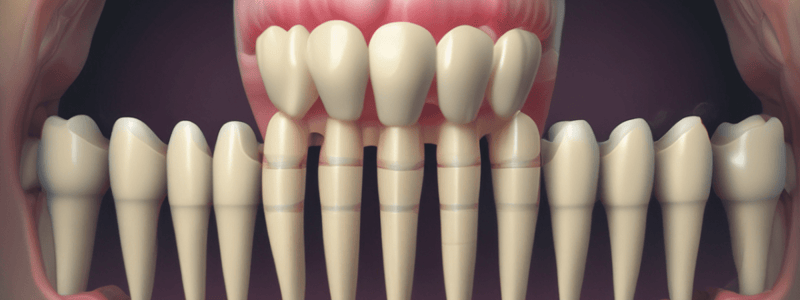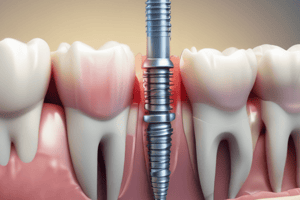Podcast
Questions and Answers
What is the composition of Mineral Trioxide Aggregate (MTA)?
What is the composition of Mineral Trioxide Aggregate (MTA)?
Tricalcium silicate, tricalcium aluminate, tricalcium oxide, silicate oxide, and other mineral oxides.
What is a characteristic of MTA that allows it to set in the presence of blood and moisture?
What is a characteristic of MTA that allows it to set in the presence of blood and moisture?
Its ability to be set in the presence of blood and moisture.
What is formed when MTA cures in the presence of calcium ions and tissue fluids?
What is formed when MTA cures in the presence of calcium ions and tissue fluids?
A reactionary layer at the dentin interface resembling hydroxyapatite in structure.
What is a potential reason why MTA prevents further microbial growth of residual microorganisms after caries excavation?
What is a potential reason why MTA prevents further microbial growth of residual microorganisms after caries excavation?
What is thought to be responsible for promoting dentinal bridging?
What is thought to be responsible for promoting dentinal bridging?
What is MTA shown to stimulate, according to studies?
What is MTA shown to stimulate, according to studies?
Study Notes
MTA Introduction
- Introduced to endodontics by Lee et al. in the early 1990s
- A bioactive silicate cement composed of: • Tricalcium silicate • Tricalcium aluminate • Tricalcium oxide • Silicate oxide • Other mineral oxides
MTA Characteristics
- Can be set in the presence of blood and moisture
- Exhibits superior marginal adaptation
- Non-absorbable
- Forms a reactionary layer at the dentin interface resembling hydroxyapatite in structure when it cures in the presence of calcium ions and tissue fluids
Biocompatible Properties
- Sustained alkaline pH after curing
- Small particle size
- Slow release of calcium ions
Biological Effects
- Stimulates cytokine release
- Induces pulpal cell proliferation
- Promotes hard tissue formation
- Inhibits microbial growth due to high alkalinity and calcium release
- Extracts growth factors from adjacent dentin, promoting dentinal bridging
Studying That Suits You
Use AI to generate personalized quizzes and flashcards to suit your learning preferences.
Description
Test your knowledge on Mineral Trioxide Aggregate (MTA), a bioactive silicate cement used in endodontics. Learn about its composition, characteristics, and applications in dental procedures. Assess your understanding of MTA as a direct pulp capping material and its use in partial or complete pulpotomy.



